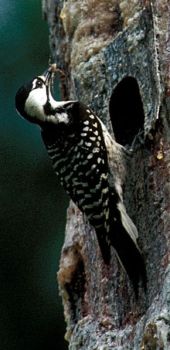Red-cockaded Woodpecker (Picoides borealis)
- Texas Status
- Endangered
- U.S. Status
- Endangered, Listed 10/13/1970
- Description
- Red-cockaded woodpeckers are 8 inches long.
- Life History
- Red-cockaded Woodpeckers sleep (roost) and nest in cavities (holes) of live pine trees. Cavities are built only in large, old pines. These woodpeckers live in family groups which may include the male and female, their chicks, and young adult "helpers". These "helpers", typically related young from previous nesting seasons, help build cavities and care for the future chicks. Pecking a cavity in a live tree takes a long time, since the wood is very hard. The birds peck the bark around the entrance to get the sap (resin) flowing around the hole. The sticky sap keeps predators like snakes away from the nest cavity. They also eat insects found under the bark and along the branches of pine trees. Females lay 2 to 4 eggs during breeding season. A woodpecker group roosts and nests in a cluster of 1 to 30 cavity trees. Most clusters have some cavities under construction, some completed and in use, and some abandoned.
- Habitat
- Open pine forests with large, widely-spaced older trees provide essential habitat for the red-cockaded woodpecker.
- Distribution
- The red-cockaded woodpecker can be found in the Pineywoods of east Texas.
- Other
- Red-cockaded woodpeckers are endangered because the open forests with big, old pine trees have been replaced by forests with younger, smaller pines. Also, periodic natural fires, which historically kept the pinewoods open, have been suppressed since settlement. Periodic fire is needed to control the brushy understory and keep the pinewoods open. In 1994, an estimated 925 red-cockaded woodpeckers lived in Texas.
